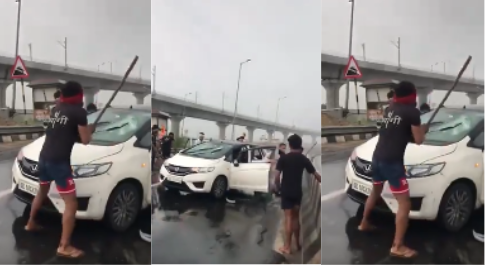This year, the situation appears more volatile than ever. In just five days since the Yatra began on July 11, more than 170 Kanwariyas have been booked across Uttar Pradesh under charges ranging from hooliganism and rioting to blocking highways, obstructing police, and disturbing public order, according to data from the Mela police control room.
– Abdul Bari Masoud
A flurry of colour and chaos opens the video. Near the bustling Mohan Nagar crossing in Ghaziabad, a silver hatchback is stuck in traffic. In seconds, a group of saffron-clad Kanwariyas surrounds it, smashing windows and the windshield with sticks and tridents. The driver pleads and leaps out as shouts of “Bol Bam!” and blaring DJ music drown his cries.
The incident occurred on July 16. Sunil Kashyap, a 28-year-old private employee, was simply driving home from work. His mistake? Trying to cautiously navigate around a Kanwar procession.
“I didn’t hit anyone. There was no space. They just started attacking,” Sunil later told reporters. “The police were right there – and did nothing.”
The video went viral, triggering public outrage. Yet, for two days, no arrests were made. Ghaziabad police only filed an FIR – against “unknown persons” – after mounting public pressure.
Earlier, on July 15, similar scenes unfolded near Meerut on the National Highway. Kanwariyas blocked traffic, vandalised vehicles, and clashed with police officers under the scorching afternoon sun.
These are far from isolated incidents. Every year during the Kanwar Yatra, reports of violence and intimidation surface from cities across northern India – Ghaziabad, Muzaffarnagar, Meerut, Bareilly, Haridwar, and even parts of Delhi.
This year, the situation appears more volatile than ever. In just five days since the Yatra began on July 11, more than 170 Kanwariyas have been booked across Uttar Pradesh under charges ranging from hooliganism and rioting to blocking highways, obstructing police, and disturbing public order, according to data from the Mela police control room.
On the ground, the atmosphere is supercharged. Slogans like “Jai Shri Ram,” “Har Har Mahadev,” and “Jo bole so nirbhay ho” blare from speakers lining the roads. Saffron flags flutter above groups of mostly young men – many wielding tridents, many more mimicking militias.
“What we’re seeing isn’t just devotion anymore,” says Ranveer Yadav, an elderly resident in western UP. “It’s a display of power. Many of these young men are unemployed, looking for identity and authority. The Yatra gives them that – unchecked.”
From Pilgrimage to Procession
Traditionally, the Kanwar Yatra was a humble religious journey – barefoot pilgrims collecting water from the Ganga. But over the past decade, particularly since the BJP rose to power, it has transformed into a grand vehicular spectacle.
Today’s processions include neon-lit trucks, DJ sound systems, and motorbike convoys escorted by local police. In 2018, the Yogi Adityanath government arranged for helicopter flower showers on the Yatra. By 2023, multiple UP districts permitted DJ systems despite NGT bans on noise pollution.
State patronage is increasingly overt. Videos from recent years show police not only escorting Kanwariyas but also offering food and dancing with them. But when violence erupts, the same police often vanish from the frame.
Had it been any other group, you’d see lathi charges and swift FIRs,” a senior police officer in Lucknow said, requesting anonymity. “But with Kanwariyas, we’re told to go easy.”
“This is dangerous appeasement,” says retired IPS officer V.N. Rai. “You’re sending the message that the law is optional if religion is invoked – especially the religion of the majority.”
Activist Kavita Krishnan echoes the concern: “This isn’t neutrality. It’s state-sponsored majoritarianism.”
Rumours, Rage, and Religious Policing
This culture of impunity has fed a cycle of aggression and misinformation. In Shahdara, Delhi, an e-rickshaw accident involving glass panels was quickly spun into a communal conspiracy. Right-wing portals and BJP leaders, including Delhi Minister Kapil Mishra – accused of inciting the 2020 Delhi riots – claimed “anti-social elements” had intentionally scattered glass to injure Kanwariyas.
Television channels jumped on the hysteria. India News aired the question, “Did a Maulana try to stop Shiva bhakts?” while News18 and OpIndia broadcast inflammatory theories, despite the Delhi Police clarifying it was just an accident.
“The communal lens is always ready,” noted a Delhi-based academic. “A Kanwar vandal can become a victim of Muslim sabotage in minutes.”
Days later, the truth emerged: the e-rickshaw driver, Kusum Pal – a Hindu – had simply lost control. But the damage had been done. “We were told it was sabotage,” said Nitin Sharma, a Kanwar camp organiser. “Now we don’t know what to believe.”
A Campaign of Quiet Exclusion
In Meerut, where the Yatra route cuts through the city, a Muslim shopkeeper has shuttered his garment store for ten days. “Last year, Kanwariyas demanded free water. When I refused, they kicked my dispenser, shouted slogans, and one even threatened to break my shop,” he said. “Police advised me to just cooperate.”
In Ghaziabad, Bijnor, and Saharanpur, Muslim shop owners take down Urdu signs or close altogether during Sawan. In Haridwar and Varanasi, right-wing groups enforce unofficial meat bans, demanding Muslim-run shops shut during the Yatra.
“We close our biryani shop every Sawan,” said Mohammad Luqman in Shahdara. “But now the pressure is different – more political.”
From demands to remove meat from displays to instructions for Muslim vendors to reveal their identities or close their businesses, the Yatra has become a vehicle for majoritarian assertion. QR codes, religious stickers, and even portraits of Vishnu’s boar avatar Varaha are being used to mark “Sanatani” shops.
In some areas, vendors are asked to display QR codes or religious symbols to prove their “Sanatani” identity. Legal scholars call it “economic untouchability.” Though the Supreme Court stayed a UP order requiring shop identity disclosures, QR-code vigilantism has filled the gap.
“There’s no Hindu vs Muslim,” says Jatin Suryavanshi, an 18-year-old Kanwariya from Bhajanpura. “Everyone should be able to do business.” But in Haridwar, video clips show saffron-clad men confronting shopkeepers, while local officials admit they’re told not to “escalate.”
Devotion or Domination?
At a Kanwar camp in Muzaffarnagar, where DJs play late into the night, 19-year-old Rajeev from Bulandshahr shrugs off criticism. “This is our time,” he says, sipping an energy drink in front of a Shiva idol. “Har Har Mahadev means no one stops us.”
“This is no longer about faith,” says sociologist Dr. T.K. Awasthi. “It’s about masculinity, dominance, and identity. Religion becomes the tool.”
Political commentator Prof. Apoorvanand adds, “This is not religious freedom. It’s religious appeasement – of the majority. The state is enabling this culture of impunity.”
Congress leader and former MP Udit Raj has even called for police verification of Kanwariyas. “Is this devotion? Fighting shopkeepers, refusing to pay, attacking rickshaws?” he asked.
Political Calculus
BJP leaders often publicly support the yatra, framing it as a symbol of “Hindu resurgence.” In 2024, Home Minister Amit Shah called Kanwariyas “cultural warriors preserving Sanatan values.”
The Opposition, meanwhile, stays quiet – fearful of being branded anti-Hindu.
“No one wants to be seen as opposing Hindu faith,” says political scientist Zoya Hasan. “Even secular parties stay silent on Kanwar violence. The silence is political.”
Back in Ghaziabad, Sunil Kashyap still hasn’t returned to work. His car is in the garage, and his confidence in public safety is shaken.
“I’m a Hindu,” he says. “But this isn’t religion. I feared for my life. If faith means violence, then what are we becoming?”
That silence – from the state, the police, and the political class – comes at a cost. Especially for ordinary citizens who expect the rule of law to apply, regardless of who breaks it.




